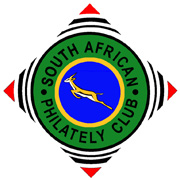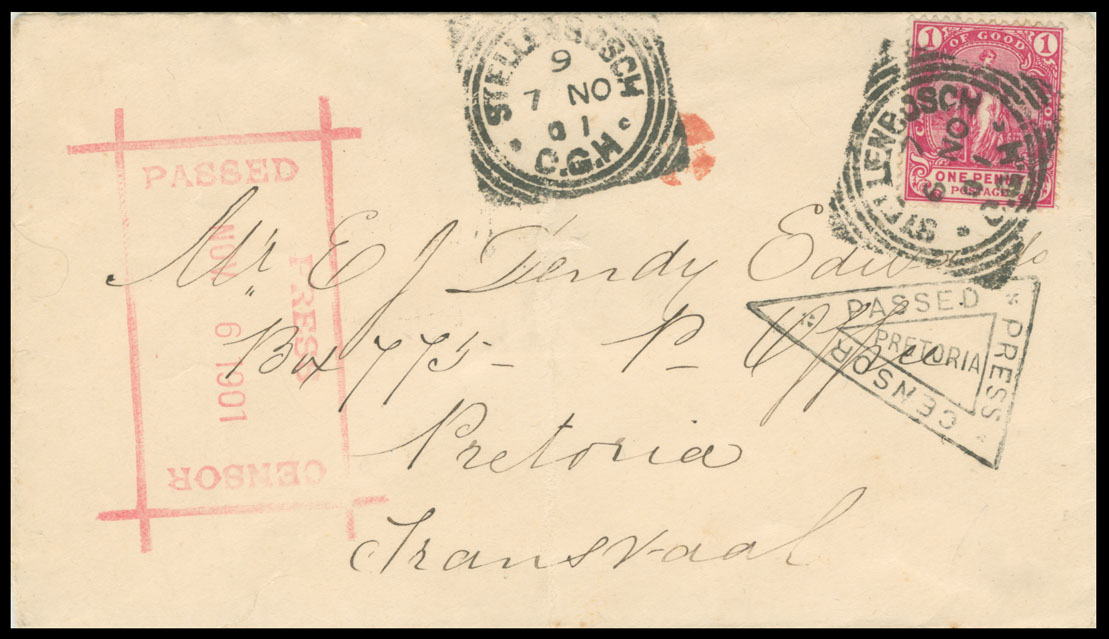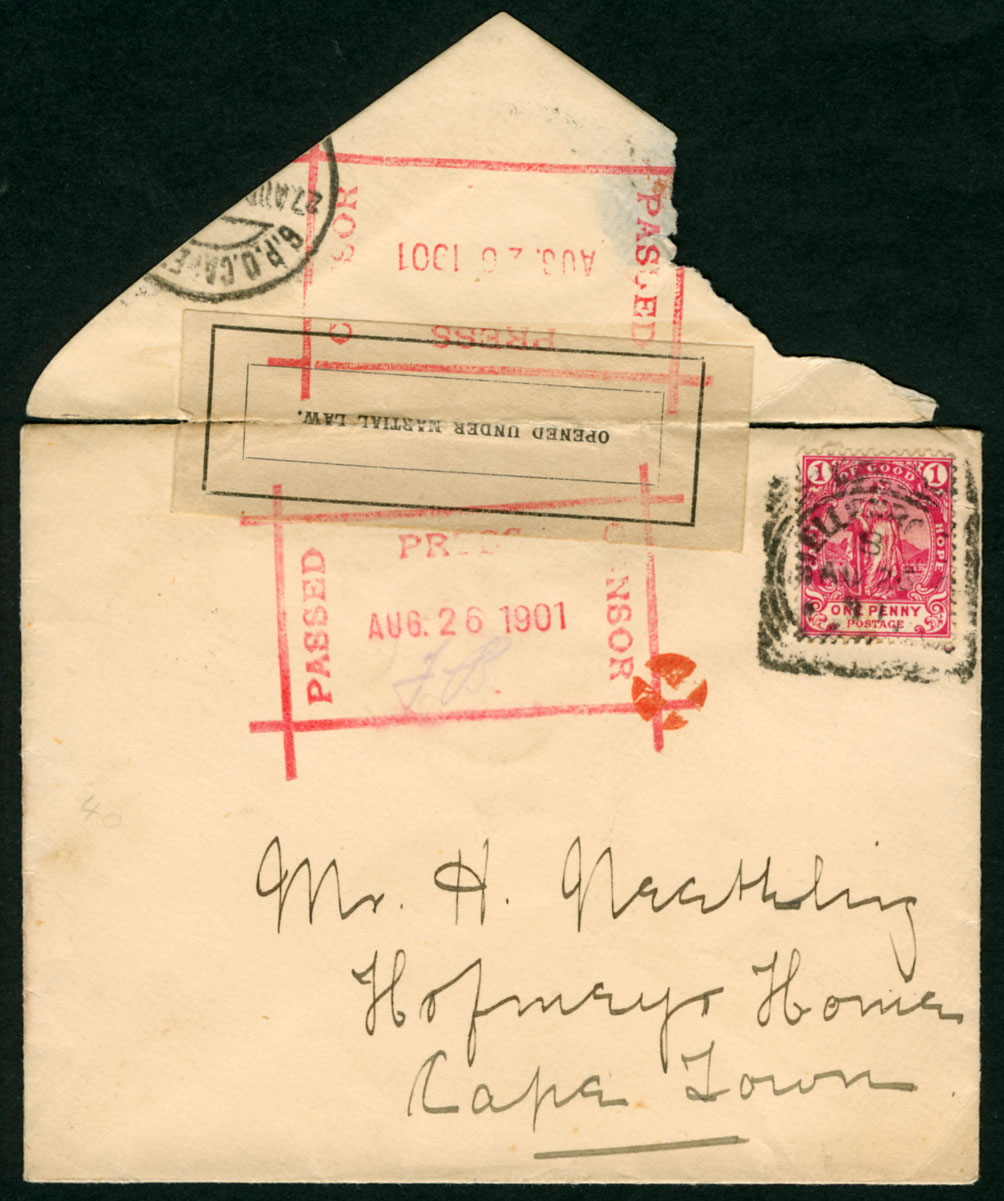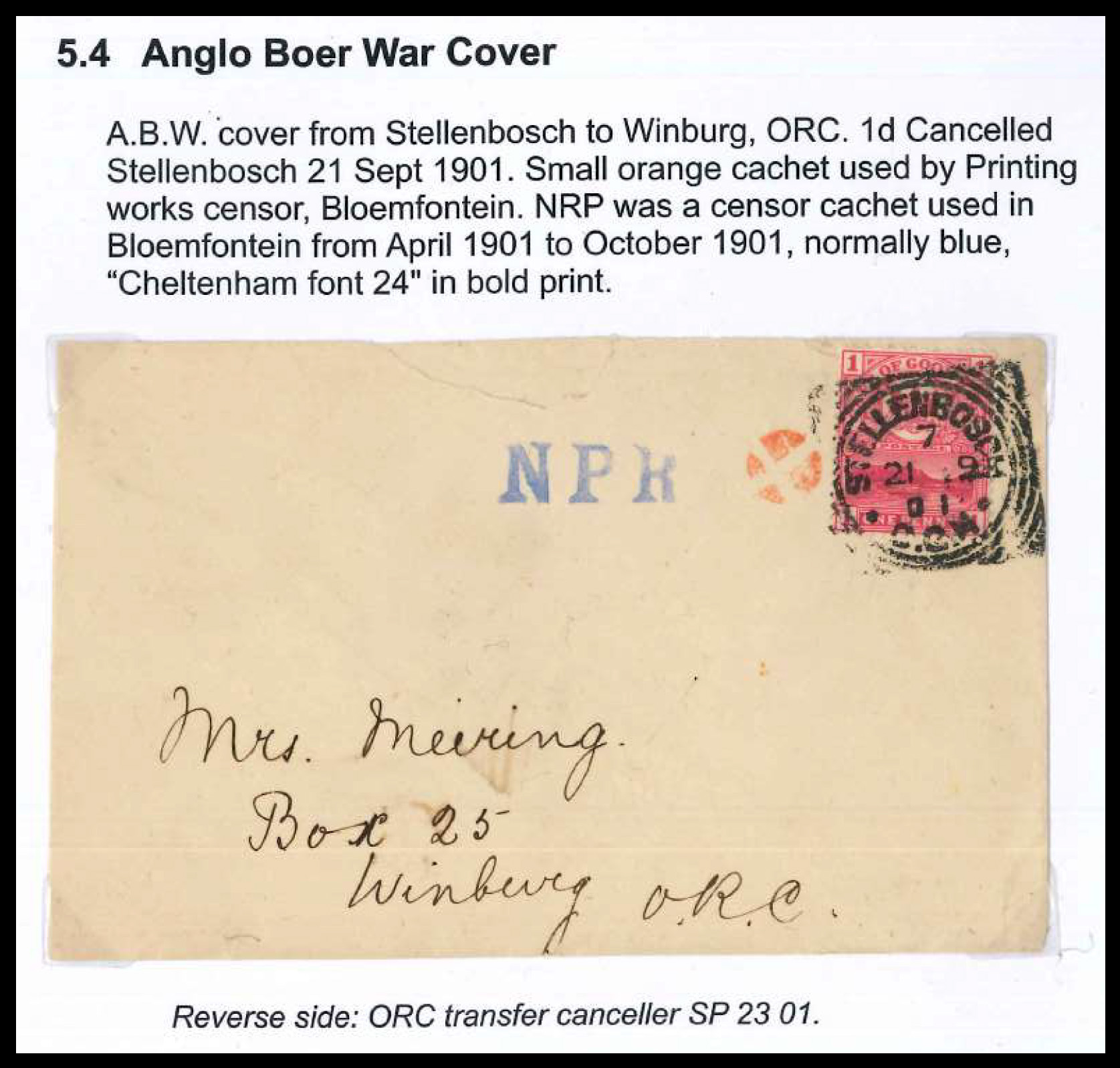Stellenbosch Remount Depot
Quote from Steve on February 1, 2023, 8:03 amSome of these covers below are shown under Cork Cancellers. Techically, these small orange 'buns' are discreet cork markers or identifiers, not cancellers. However, their method of manufacture was much the same as a postal 'cork canceller'. This has been made from the cork of a small bottle, probably a medicine one. The cork has been quartered unevenly, as often happened with ad hoc solutions.
What its purpose was, I do not know but my guess is that it was an office admin mark that showed that the letter was either to be censored or had been censored. The two examples below and the one in Gawie Hugo's 'Table Mountain, The Inspiration' display, are the only examples I have seen. There must be more. As all three covers are from Stellenbosch, I assume that these office admin marks were applied there, not elsewhere as Gawie states. There is no eveidence to show where these are from. However.....
During the South African War horses were key to the mobilityof the combatants by late 1901 when these covers were 'marked'. There was a large Remount Depot in Stellenbosch when in April 1901 General Jan Smuts invaded the Cape Colony. Born in Riebeek West in 1870, some 75km from Cape Town, he was educated in Stellenbosch. He rallied some 3,000 Cape Boers to the Republican cause, including my great uncle Elias Nel from Calvinia. For a time some of his Boer forces were based in the Hex River Valley, some 70 miles (112km) from Stellenbosch. At one point Smuts was said to be close enough to Cape Town to see Table Mountain. The possibility of Smuts capturing Stellenbosch and its Remount horses and igniting a wider rebellion among the Cape Dutch sent the British into a 'flap' between August and November 1901. Even Cape Town was a bit panicked at this time by the proximity of Boer forces. To reassure the HM's obedient subjects extra security measures were introduced, like the tightening up of censorship. Letters from Stellenbosh were either marked with the small orange cork identifier to show they were yet to be censored, or more likely as all mail had to be censored, that the letter had already been censored and was approved for posting. This theory may have nothing to do with Jan Smut and horses! If we could find other examples to show this was normal procedure, my theory might evaporate like Karoo rain.
The dates of my three recorded covers are: 26 August 1901; 21 September 1901 and 7 November 1901. Only the earliest cover has an 'OPENED UNDER MARTIAL LAW." label. Had they run out of labels by 21st September or were they no longer a requirement? The topmost cover is the most interesting. It was cancelled on the 6th November and PASSED PRESS CENSOR on the same day. It was cancelled with a post office canceller the next day, presumably when it entered the postal system. Between the 6th and the 7th it received the 'bun' cork identifier. The question is "why?" Did this signify that it had been censored and was 'ready to go'?
The bottom cover has no censor mark but bears the orange 'bun' cork identifier. Its caption states that it was used by the 'Printing works censor, Bloemfontein'. My guess is that it was not and that it was applied in Stellenbosch, the town being the common thread between all three covers. ('N P R' refers to the initials of Major N.P. Rogers, the Chief Censor of the British Army in Bloemfontein. Presumably he censored and or passed the letter on its arrival in Bloemfontein bound for Winburg but did NOT apply the orange 'bun'!).
If anyone has another example or knowledge of this particular cork 'bun', please share it with us here.
The bottom cover is from Gawie Hugo's 'Table Mountain - The Inspiration' display which you can see by Clicking Here.
Uploaded files:
Some of these covers below are shown under Cork Cancellers. Techically, these small orange 'buns' are discreet cork markers or identifiers, not cancellers. However, their method of manufacture was much the same as a postal 'cork canceller'. This has been made from the cork of a small bottle, probably a medicine one. The cork has been quartered unevenly, as often happened with ad hoc solutions.
What its purpose was, I do not know but my guess is that it was an office admin mark that showed that the letter was either to be censored or had been censored. The two examples below and the one in Gawie Hugo's 'Table Mountain, The Inspiration' display, are the only examples I have seen. There must be more. As all three covers are from Stellenbosch, I assume that these office admin marks were applied there, not elsewhere as Gawie states. There is no eveidence to show where these are from. However.....
During the South African War horses were key to the mobilityof the combatants by late 1901 when these covers were 'marked'. There was a large Remount Depot in Stellenbosch when in April 1901 General Jan Smuts invaded the Cape Colony. Born in Riebeek West in 1870, some 75km from Cape Town, he was educated in Stellenbosch. He rallied some 3,000 Cape Boers to the Republican cause, including my great uncle Elias Nel from Calvinia. For a time some of his Boer forces were based in the Hex River Valley, some 70 miles (112km) from Stellenbosch. At one point Smuts was said to be close enough to Cape Town to see Table Mountain. The possibility of Smuts capturing Stellenbosch and its Remount horses and igniting a wider rebellion among the Cape Dutch sent the British into a 'flap' between August and November 1901. Even Cape Town was a bit panicked at this time by the proximity of Boer forces. To reassure the HM's obedient subjects extra security measures were introduced, like the tightening up of censorship. Letters from Stellenbosh were either marked with the small orange cork identifier to show they were yet to be censored, or more likely as all mail had to be censored, that the letter had already been censored and was approved for posting. This theory may have nothing to do with Jan Smut and horses! If we could find other examples to show this was normal procedure, my theory might evaporate like Karoo rain.
The dates of my three recorded covers are: 26 August 1901; 21 September 1901 and 7 November 1901. Only the earliest cover has an 'OPENED UNDER MARTIAL LAW." label. Had they run out of labels by 21st September or were they no longer a requirement? The topmost cover is the most interesting. It was cancelled on the 6th November and PASSED PRESS CENSOR on the same day. It was cancelled with a post office canceller the next day, presumably when it entered the postal system. Between the 6th and the 7th it received the 'bun' cork identifier. The question is "why?" Did this signify that it had been censored and was 'ready to go'?
The bottom cover has no censor mark but bears the orange 'bun' cork identifier. Its caption states that it was used by the 'Printing works censor, Bloemfontein'. My guess is that it was not and that it was applied in Stellenbosch, the town being the common thread between all three covers. ('N P R' refers to the initials of Major N.P. Rogers, the Chief Censor of the British Army in Bloemfontein. Presumably he censored and or passed the letter on its arrival in Bloemfontein bound for Winburg but did NOT apply the orange 'bun'!).
If anyone has another example or knowledge of this particular cork 'bun', please share it with us here.
The bottom cover is from Gawie Hugo's 'Table Mountain - The Inspiration' display which you can see by Clicking Here.
Uploaded files:
Uploaded files:Quote from Steve on August 18, 2025, 2:14 pmFurther to "During the South African War horses were key to the mobility of the combatants ... in April 1901 General Jan Smuts invaded the Cape Colony. Born in Riebeek West in 1870, some 75km from Cape Town, he was educated in Stellenbosch. He rallied some 3,000 Cape Boers to the Republican cause. ... For a time some of his Boer forces were based in the Hex River Valley, some 70 miles (112km) from Stellenbosch. At one point Smuts was said to be close enough to Cape Town to see Table Mountain."
So, in order to give some further legs and local colour to this tale 'Of 'Horses and Men', (the original title of Denys Reitz's 'Commando', much of which dealt with the invasion of the Cape,), I attach the following images, one a modern postcard of the Hex River Valley in autumn, always a mysterious and brooding place, and an Edwardian postcard from 5th November (Guy Fawkes Night) 1903, some two years after the events described above. The red and orange areas are vineyards showing their spectacular autumn colours.
Circa 1970. Postcard. 'Autumn View of the Hex River Valley, Cape'.
Terence J. McNally (Pty) Ltd. (Terry Press. Cape Town, Durban, Pretoria.)
1903. Postcard. HEX RIVER 'NO 5 03' to CAPE TOWN 'NO 6 03'.
Further to "During the South African War horses were key to the mobility of the combatants ... in April 1901 General Jan Smuts invaded the Cape Colony. Born in Riebeek West in 1870, some 75km from Cape Town, he was educated in Stellenbosch. He rallied some 3,000 Cape Boers to the Republican cause. ... For a time some of his Boer forces were based in the Hex River Valley, some 70 miles (112km) from Stellenbosch. At one point Smuts was said to be close enough to Cape Town to see Table Mountain."
So, in order to give some further legs and local colour to this tale 'Of 'Horses and Men', (the original title of Denys Reitz's 'Commando', much of which dealt with the invasion of the Cape,), I attach the following images, one a modern postcard of the Hex River Valley in autumn, always a mysterious and brooding place, and an Edwardian postcard from 5th November (Guy Fawkes Night) 1903, some two years after the events described above. The red and orange areas are vineyards showing their spectacular autumn colours.
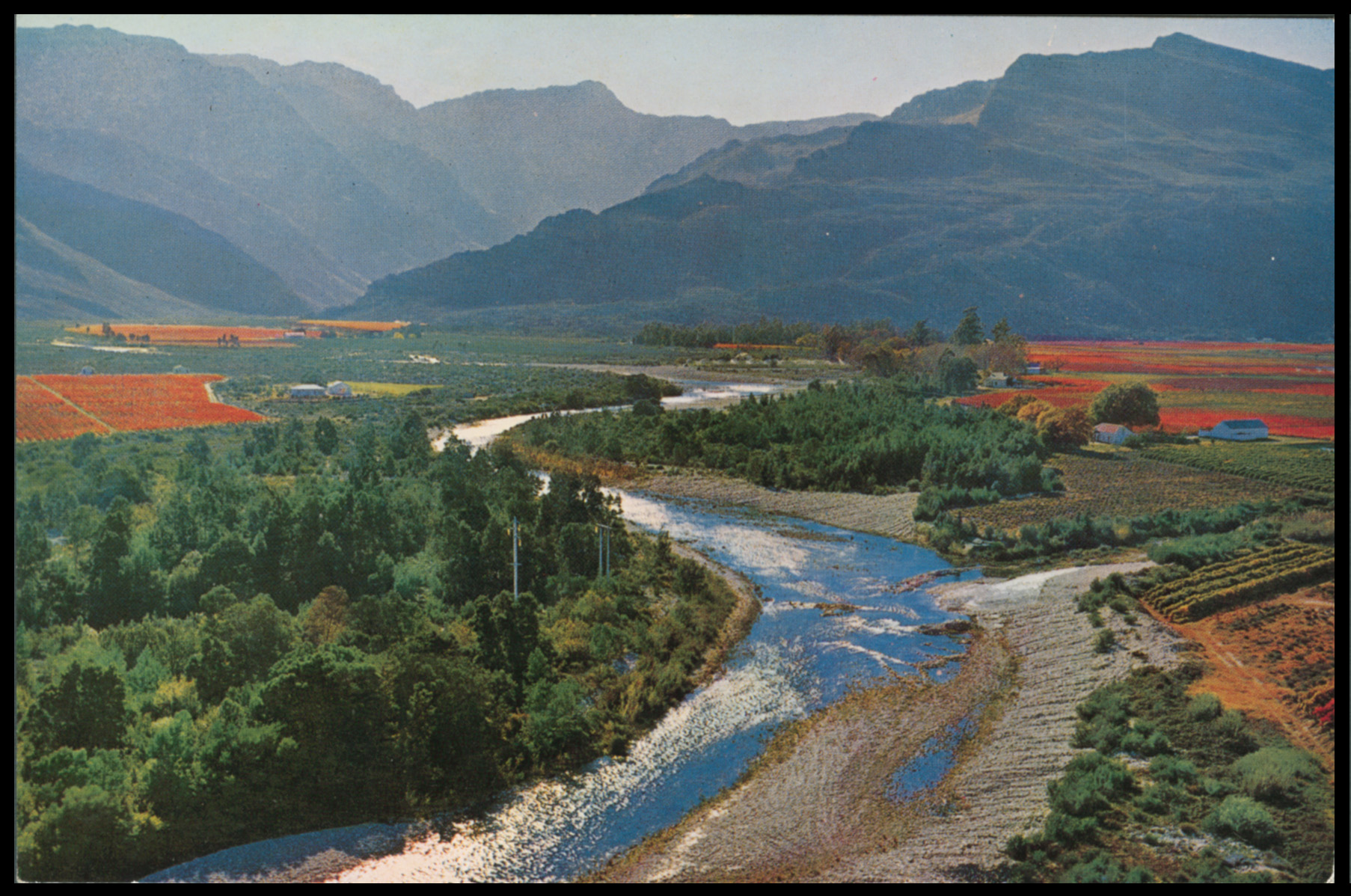 Circa 1970. Postcard. 'Autumn View of the Hex River Valley, Cape'.
Circa 1970. Postcard. 'Autumn View of the Hex River Valley, Cape'.
Terence J. McNally (Pty) Ltd. (Terry Press. Cape Town, Durban, Pretoria.)
 1903. Postcard. HEX RIVER 'NO 5 03' to CAPE TOWN 'NO 6 03'.
1903. Postcard. HEX RIVER 'NO 5 03' to CAPE TOWN 'NO 6 03'.
